Cet oiseau a été
photographié
par Jean-Yves
PIEL au bord de la
mer Rouge entre Qseir et Marsa Allam (ca 25°
15’ N, 34° 50’ E, Égypte, voir
carte)
le 31 décembre 1998. A little bigger than a
Chiffchaff. Compléments de Jean-Yves
Piel : ? Le sourcil me semble
vraiment très marqué jusqu'à
la base du bec
(obvious eyebrow to the bill base) ? Les barres alaires
incontestables ainsi que la couleur foncée
de la plage
« alula »
(obvious wing-bars and dark alula) ? Les pattes ont une
couleur sable très
clair (very light
sandy leg color) ? L'attitude
générale de l'oiseau qui ne se tient
pas assez droit pour un traquet et qui ne laisse
pas « tomber » ses
ailes (no upright
stance, no dropping wings unlike
wheatear) ? Enfin, une attitude trop
farouche &endash; l'oiseau ne s'est pas
laissé approcher contrairement aux
manifestations générales de
curiosité des traquets du
désert (too shy
bird, not so tame as a
wheatear). Je pense que la piste
'Traquet' n'est pas à rejeter mais j'ai
beaucoup de mal à accepter les propositions
concernant le motteux &endash; ce serait une grande
première en Egypte, à cet endroit et
à cette époque de l'année. Un
détail qui nous est revenu à l'esprit
aujourd'hui, la pointe extrême des rectrices
était assez nettement plus claire. Quant
à la Fauvette naine 'atypique', je n'en ai
jamais observé mais en relisant ma
littérature, c'est effectivement un oiseau
possible à cet endroit et à cette
époque mais pourrait-elle être à
ce point atypique pour présenter ces patterns
(œil, sourcil, barres alaires et queue)
? Je ne sais pas si on aboutira
à une conclusion mais j'avoue que toute cette
discussion est fort intéressante et je remercie
tous les intervenants de leurs
propositions. 20·3·00 :
Que reste-t-il à ajouter d'utile sur cette
observation ? (some
useful new comments)
C'était en fin d'après-midi avec un
soleil relativement bas sur l'horizon et par vent
très fort comme c'est souvent le cas sur le
bord de la mer Rouge
(late afternoon, low sun
and strong wind), ce qui
rend l'observation difficile et surtout la prise
d'images. In natura, l'oiseau nous avait paru
petit (in the field the
bird seemed small to us)
et nous n'avions pas pu
déceler le fameux pattern en T typique du genre
Oenanthe qui saute toujours aux yeux (contraste de
couleurs) en zone désertique. Ce n'est qu'en
« découvrant » l'image
n° 2 que nous avons eu la surprise de voir
ce fameux pattern en T (la queue fut en fait fort
probablement rabattue par le vent au moment de la
prise de vue) (the tail
pattern was only discovered on the picture and not in
the field). J'ai donc
demandé l'aide d'Alain car je n'avais pas
vraiment de solution convaincante à apporter
moi-même à cause d'éléments
apparemment contradictoires (taille, pattern de la
queue et couleur des pattes entre autres). Si je me risque maintenant
à une synthèse des propositions
avancées, je pense qu'il me faut abandonner les
précisions apportées au début sur
la taille de l'oiseau et rester sur l'hypothèse
d'un individu du genre Oenanthe de petite
taille (we have now to
forget the alleged small size and the Phyllscopus
track to keep on a small
wheatear) car je
reconnais que le dessin de la queue est un
élément prépondérant. Je
suis particulièrement convaincu par les
argumentations d'Andrew Grieve et de Mike
Crew (I’m quite
convinced by Andrew Grieve and Mike Crewe opinions)
et je pencherai
personnellement pour les deux conclusions suivantes en
retenant cependant la suggestion de Mike sur la
possibilité d'être en présence
d'un individu leucique
(why not a leucistic bird as suggested by
Mike?) pour expliquer les
pattes très claires : - Soit une femelle de
Traquet de
Finsch/Finsch’s
Wheatear d'autant que
j'en ai souvent observé des individus hivernant
dans cette région et à cette
époque (often
watched in the area on
December) ; - Soit un immature tardif de
Traquet
motteux/Northern
Wheatear imm., mais
j'avoue que sa présence en ces lieux et
à cette époque me laisse un peu
dubitatif (but... date is
unusual). Envoyez, s'il vous
plaît, une copie de votre réponse à Merci !
Thanks!
(Red Sea, between Qseir and
Marsa Allam/Egypt, ca 25° 15' N, 34° 50' E, 31th
December 1998, see map)Taille
légèrement plus grande que celle d’un
Pouillot véloce Phylloscopus collybita.
Barre alaire des grandes couvertures assez droite et
d’épaisseur continue.
Barre alaire des moyennes couvertures plus ou moins
visible selon éclairage ou position de
l’oiseau.
Alula sombre.
Pattes beige clair.
Aucun cri entendu.
Toujours au sommet de cette végétation
buissonnante de 30-40 cm (Chenopodiacae,
type Salicornia ou Sacocornia).
Greater coverts wing bar quite straight and with regular
width, dark alula,
median coverts more or less obvious according to light or
attitude.
Light beige legs.
No calls.
Always on top of this plant (Chenopodiacae,
Salicornia/Sacocornia-like.14·3·00
: Si l'on s'en tient au pattern de la queue,
effectivement, tout porte à croire que nous
sommes en présence d'un traquet. Cependant, et
je suis formel là-dessus, il n'y a pas de
trace de noir dans le pattern de la
queue (no black in
the tail). Dans le
genre Oenanthe, la seule réponse que je vois
possible est le Traquet à capuchon
femelle (maybe a female
Hooded Wheatear?)
(Oenanthe monacha) d'autant plus que nous sommes dans
son aire de répartition. Le T de la queue
est chamois foncé et le bord externe des
rectrices externes est également
foncé
(tail-T is dark buff with dark edge on the outer
rectrices). Le
pattern de la tête correspond également
assez bien, avec ce regard caractéristique
dû au rétrécissement de la boite
crânienne à la hauteur des yeux. Ce jour
là (this day were
watched too:) d'ailleurs
en consultant ma banque d'observations, nous avons
enregistré le Traquet à tête
blanche (O. leucura), le Traquet pie (O. pleshanka),
le Traquet du désert (O. deserti), le Traquet
deuil (O. lugens) et le Traquet à capuchon (O.
monacha). Restent cependant des problèmes
à
résoudre/a few
unsolved questions for a
wheatear :
? A peine plus grand
que le Pouillot véloce. Disons 12 cm,
maximum 12,5 cm (size
around 12-12,5 cm)
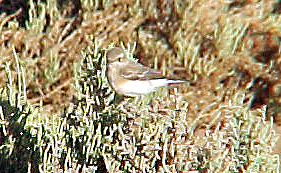
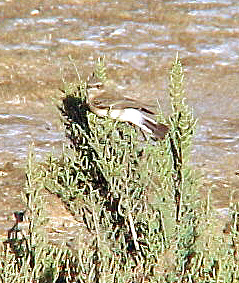
please forward a copy of your
answer to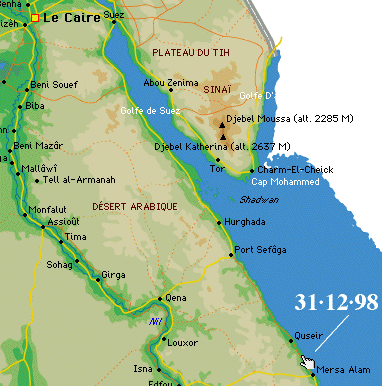
Jean-François
Le Bihan, France
(14·3·00) Traquet oreillard/Black-eared
Wheatear (Oenanthe hispanica) S.
Cummings, UK
(15·3·00) : At first I thought of Desert
Wheatear but they have solid black tails. Working from the
illustations in Birds of the Middle East, Porter et al
(Poyser), 1st Winter Black-eared Wheatear seems favourite.
Note the white "half-H" shape on the tail
(black-eared/Pied/Finsch`s?). To my mind, the supercillia,
all white vent, lower breast and flanks, and warm ruffous
tinge to the breast sides near the wing joint, point to
Black-eared wheatear..........maybe. Alf
Tore Mjøs,
Norvège (14·3·00) :
melanoleuca Thierry
Fournet, France
(15·3·00) Traquet motteux/Northern
Wheatear (Oenanthe oenanthe) Jean-Philippe
Paul, France
(14·3·00) : A part la description des pattes
(que l'on ne voit pas sur les photos et qui ne correspond
à aucun traquet de toute façon -beige clair?-)
je ne vois pas ce qui exclut le Traquet motteux mâle
en hiver d'autant que la queue élimine bon nombre
d'autres Oenanthe, à part peut-être une femelle
"halophila" de T. deuil. En cette heure tardive,
voilà sur quoi je mise en imaginant une couleur des
pattes faussée par une forte
lumière. Mike
Crewe, UK
(14·3·00) : The mystery bird in Egypt appears
to be a juvenile Northern Wheatear (Oenanthe oenanthe)
although, it is a remarkably late date for a bird so
young. Neil
Donaghy, UK
(14·3·00) : From the tail pattern this looks
like a wheatear species[possibly Northern by the amount
of black present] but I'm afraid I cannot say which
one. Nicolas
Selosse, Belgique
(14·3·00) Sean
Cole, UK
(14·3·00) Jean-Yves
PIEL, Égypte
(20·3·00) see above Thierry
Fournet, France
(28·3·00) Traquet isabelle/Isabelline
Wheatear (Oenanthe isabellina) Alain
Fossé, France
(14·3·00) Emmanuel
Roy, France
(14·3·00) Dick
Newell, UK
(14·3·00) Traquet deuil/Mourning Wheatear
(Oenanthe lugens) Jean-Philippe
Paul, France
(14·3·00) (cf. ci-dessus/see above) Traquet de Finsch/Finsch’s
Wheatear (Oenanthe finschi) Maxime
Zucca, France
(14·3·00) : Bizarre ... Moi j'dirais hybride
traquet X paruline ! Non sérieusement on dirait un
traquet , mais les barres alaires et la taille
indiquée (un peu + gros que le véloce) sont
étranges . Mais le pattern de la queue plaide
totalement en faveur d'un traquet , ainsi que la posture de
l'oiseau sur la photo 2 et son perchoir . Sans du tout
connaitre cette espèce je trouve qu'il ressemble ,
d'après ce qu'on voit ds le livres , au traquet de
Finsch . Mais bon ... Andrew
Grieve/OSME
(17·3·00) : It is always difficult from
pictures like these to identify the species concerned. If
the bird was a species of wheatear (which appears to be the
case from the tail pattern) then most Wheatear species can
be ruled out on size alone. Even the small wheatear species
are 2cm larger than your measurement. However, possibly some
of the smaller wheatear species may look small when perched
on small plants alongside the Red Sea. Jean-Yves
PIEL, Égypte
(20·3·00) see above Traquet à capuchon
femelle/female Hooded Wheatear (Oenanthe
monacha) Jean-Yves
PIEL, Égypte
() Traquet pie/Pied Wheatear
(Oenanthe pleschanka) Philippe
J. Dubois, France
(15·3·00) : C’est très
probablement un Traquet pie, femelle ou peut-être
mâle de 1er été. Traquet à poitrine
rousse/Red-breasted Wheatear (Oenanthe
bottae) Teus
Luijendijk, Pays-Bas
(26·3·00) : I am not at all familiar with the
species, but the only option I can come with is that the
bird is a Red-breasted Wheatear Oenanthe bottae, a species
from e.g. Ethiopia. The bird is (I think) surely a wheatear,
as shown by the white rump and the tail pattern. The
brownish upperparts, reddish breast, white markings on
throat and head seem to favour the id. as a O. bottae,
presumably a young bird or a female. The small size would
also be in favour for this species. But again, I have never
seen this species myself, so I could still be
mistaken. Tarier de
Sibérie/Siberian Stonechat (Saxicola (torquata)
variegata) Thomas
W. Johansen,
Danemark (14·3·00) : It looks like a wheatear
- but if it is as small as a chiffchaff i could be an
Stonechat of the subspecies Varigata (a young female maby).
But it is hard to see on the picture. It would be
interesting with bigger magnification and other
angles. Pouillot de Hume/Hume’s
Warbler (Phylloscopus humei) Jean-Yves
PIEL, Égypte
(31·12·98) William
Oliver, UK
(14·3·00) Pouillot du Caucase/Caucasian
Chiffchaff (Phylloscopus collybita lorenzii) Jean-Yves
PIEL, Égypte
(31·12·98) William
Oliver, UK
(14·3·00) Pouillot
verdâtre/Two-barred Greenish Warbler (Phylloscopus
trochiloides plumbeitarsus) John
Azzopardi, Malte
(14·3·00) : The bird in question resembles a
1st winter Two-barred Grenish Warbler (Phylloscopus
trochiloides plumbeitarsus) from the extralimital eastern
range. However, this bird usually has darker legs (hence its
name plumbeitarsus). Pouillot boréal/Arctic
Warbler (Phylloscopus borealis talovka) John
Azzopardi, Malte
(14·3·00) : A bird which is similar but with
lighter legs and also slighly larger than a chifchaff is the
Arctic Warbler (Phylloscopus borealis talovka). The 1st
winter bird of this species is similar to the one shown in
the photo. Fauvette naine/Desert Warbler
(Sylvia nana) Jean-François
Le Bihan, France
(14·3·00) Alain
Fossé, France
(21·3·00) : why not an imm.? overall color,
dark contrasting alula, pale legs, growing white outer
rectrices, but... the eye doesn’t seem pale (but quite
head-on view)... about same
place, march
2000 Traquet du désert/Desert
Wheatear (Oenanthe deserti) Kees
Bakker, Pays-Bas
(30·3·00) Traquet motteux/Northern
Wheatear (Oenanthe oenanthe) Derrick
Marven, Canada
(30·3·00) : Why is it a Desert Wheatear and
not a Northern. I've just been looking at Lars Johnsson's
book, i can see that the bird looks a little pale but the
black eyestripe looks like an imm Northern male. Having
never seen either some sort of explanation would be
helpfull. Mike
Crewe, UK
(1·4·00) : I'm rather bemused by the latest
wheatear offering. All features scream adult winter male
Northern Wheatear/Traquet Motteux. What's the catch - is
this a test?!
The classic tail pattern of an inverted Black T-shape with
white sides can only point to a wheatear species, and this
is supported by the bird's behaviour (sitting on top of
bushes) and by structural points (the longish tail, long,
tapering wings and general shape). The lack of black in the
plumage (other than on the tail) rules out many species,
whilst the tail pattern rules out several others. The
combination seems to point to Northern, rather than Pied (O.
pleschanka) or Black-eared (O. hispanica melanoleuca), both
of which would show less black at the tip of the tail
feathers.
The bird can be aged as a juvenile by the spotted juvenile
feathers present on the breast sides and crown. The pale
tips to the otherwise very dark median coverts and the dark
alula are all typical. The obvious pale wingbar formed by
pale tips to the greater coverts is unusual, but is
sometimes found in juvenile Northern Wheatear. The strong
supercilium and apparent markings on the crown may suggest
Whinchat (Saxicola rubetra) but that species is ruled out by
long tail and wings and by the rather long, typical wheatear
legs just detectable in the left hand photo.17·3·00 :
After reading the range of suggestions on Jean-Yves
Piel's website, I feel I must run over the features of
the bird again.
Photo 2 gives a very good view of the tail pattern, which
clearly consists of a very dark brown/blackish terminal
or sub-terminal band to all feathers, whilst the central
feathers are completely dark. The rest of the tail is
gleaming white. This rules out every possible species
(including all warblers/fauvettes!!!) except
Whinchat/Tarier d'Europe/ Saxicola rubetra, Red-breasted
Flycatcher/Gobemouche nain/ficedula parva or a number of
wheatears/traquets/Oenanthe spp.
Whinchat is ruled out because it does not have a white
rump. Red-breasted Flycatcher is ruled out because it
does not have a strong white supercilium. Other people
suggested Stonechat of race variegata (Tarier
patre/Saxicola torquata variegata) but only adult male
would show as much white, and that would have a dark
throat and no bold, white supercilium.
So it must be a wheatear/traquet - but which one? Perhaps
we need to consider each species. But first, we can
dismiss the following because tail pattern is wrong:
Desert (O. deserti), Hooded (O. monacha), White-crowned
Black (O.leucopyga), Red-rumped (O. moesta).
Since Jean-Yves Piel suggests Hooded Wheatear/Traquet a
Capuchon, I should say that that species has much less
dark in the tail and only an adult male would show so
much white. An adult male would be boldly black and white
all over. Hooded Wheatear also has a surprisingly large
bill, almost like a small thrush/petite grive.
Other wheatears we can dismiss include:
Cyprus Wheatear (O. cypriaca) - always much darker above
and with dark throat.
Finsch's Wheatear (O. finschii) - male dark-throated.
Female much greyer, not brownish or buffy in colour.
Black Wheatear (O. leucura) - always blackish on whole
head.
Red-tailed Wheatear (O. xanthoprymna) - never has white
rump.
Mourning Wheatear (O. lugens) - race lugens is boldly
black and white with contrasting buff undertail coverts.
Race halophila does not occur in the area. The female of
this race is also much greyer, not brown above.
Isabelline Wheatear (O. isabellina) - tail is relatively
shorter than on this bird. Also, supercilium would not be
as obvious behind the eye and the bird would have a
different outline with, especially, a larger head and
bill.
So we must choose from three species: Northern
(O.oenanthe) , Pied (O.pleschanka) or Black-eared
(O.hispanica melanoleuca) = Traquet motteux, T. pie ou T.
oriellard (de orientale).
The bird seem to show some features of Pied and some of
Black-eared. In favour of Pied: typical breast pattern,
overall jizz, apparent mottling or scaling to crown and
mantle. In favour of Black-eared: contrastingly white
throat and rather warm upperparts (photo 2). However, I
think both species would show a different tail pattern.
They would show less black on the tips of the 5th pair of
tail feathers, increasing outwards to the outermost (1st)
pair which would show extensive black running up the
outer edge. A few years ago I saw a bird very similar to
this in Essex, England. It was claimed as an uncertain
Pied or Black-eared. The bird turned out to be a juvenile
Northern Wheatear which had retained some of the mottling
typical of young juveniles. I believe this is a late
juvenile Northern Wheatear, although I think we would
like to see more pictures of a better quality to be sure.
It is very interesting that Jean-Yves describes the tail
differently to how it looks in the photos. If it DOES
show dark running up the outer rectrices, it may very
well be a Black-eared Wheatear - or perhaps a Pied of the
rae 'vittata' form! More photos please!!
I feel I should also attempt to answer some of Jean-Yves'
questions:
1. No black in the tail. It is possible for juvenile
Northern to show a rather brownish tail. Alternativley,
the bird could be somewhat leucistic, which would result
in black plumage areas looking browner.
2. Size 12-12,5cm. Size is very difficult to judge on a
loan bird and it is easy to be fooled.
3. Obvious eyebrow to the bill base. This is perfectly
normal for Northern.
4. Obvious wingbars and dark alula. Both features are
variable in wheatears and can be shown by several
species, including Northern.
5. Very light sandy leg colour. I think the key word here
is sandy! It is quite possible that the bird had got
dirty legs. All wheatears have black legs. It is just
possible that they were paler than usual if the bird was
leucistic (see above).
6. No upright stance or dropping wings unlike wheatear.
Stance can vary greatly according to weather conditions
and condition/health of the bird. Wheatears don't
habitually drop their wings all the time - they are
painted like that in field guides so you can see the rump
pattern!!
7. Too shy, not so tame as a wheatear? Bird behaviour is
very variable. Not all wheatears are approachable.16·3·00 :
j'ai été voir les commentaires
ajoutés à la photo : comment ça "pas
de traces de noir ds le
pattern de la queue" ?? Parle-t-on du mÍme oiseau
? le traquet à
capuchon femelle n'a pas du tt le pattern caudale de
l'oiseau sur la photo : le
blanc est remplacé par du roux orangé
. De toutes façon
comme je l'avais déjà écrit , je ne
vois pas comment avec une
telle queue on peut écarter un traquet du genre
"oenanthe" , non ? Moi
j'avais pensé au Finsch , (regardez le dessin ds
le GEOPO p 637 femelle
à gorge pâle) . JY
Piel ajoute ici un critère : la pointe des
rectrices pâle : le
fincsh présente svt un tel critère (mais ce
n'est pas le seul) . Le pb
avec le Finsch , c'est la coloration du dos , par exemple
. Encore que ... Mais
Ítes vous vraiment si sur de la taille ? Pour les
traquets , il vaut mieux proceder par élimination
. Le pattern de la queue
(allié avec le plumage qui n'est de toute
évidence par celui
d'un mâle) élimine : traquet du
désert , traquet isabelle ,
traquet à capuchon , traquet
à tète blanche , traquet à queue
rousse , traquet à
tète grise et les tariers .
Il nous reste donc : motteux ,
oreillard , pie , chypre , finsch , deuil ,
rieur . Par le plumage je pense
qu'on peut d'office éliminer le chypre et le
rieur.
The time of year would normally rule out Northern and
Black-eared Wheatear as these two species do not usually
winter in Egypt, though a few Northerns have been recorded
in the past. There have been 2 records of Black-eared
Wheatear in December, one, a female in winter plumage, I saw
myself and it was nothing like the species depicted, being
much darker brown.
The tail pattern excludes Northern Wheatear because the
central black area extends too far up the tail towards the
rump for Northern Wheatear.
Hooded Wheatear can also be ruled out, it is much bigger for
one thing but the tail pattern is also wrong, Hooded
Wheatear have white sides to the T of the tail.
Mourning Wheatear have the orange vent and are much blacker
in the wings so this species is also ruled out.
Desert and Isabelline Whaetear have a much thicker black
band across the tail with no length of black extending up
the tail, so it is clearly not those two species.
Eastern Pied Whaetear is much darker brown and has as yet
not been recorded in Egypt.
So that leaves Pied, Cyprus and Finsch's Wheatear, if it is
a wheatear spp and these all winter in Egypt and these
species also show the distintive tail pattern depicted in
the 2 pictures.
Both Cyprus and Pied Wheatear (female/immatures) tend to be
darker, almost approaching Eastern Pied in colouration,
though not as dark. The species depicted in the 2 pictures
just does not look dark enough for either Cyprus or Pied
Wheatear.
It is, however, similar to a female Finsch's Wheatear
(Oenanthe finschii). Finsch's is probably one of the
smallest wheatears and is not depicted very accurately in
most field guides. I have noticed with female/immature birds
wintering in Egypt that they sometimes exhibit a well marked
supercillium. They can also look grey on the top of the head
and mantle and show a more marked smudgey breast area
extending further down than shown in field guides. They are
probably also regular winter visitors to the area where
these pictures were taken and I have seen then perching on
vegetation quite close to the sea in Sinai.
But as I say, it is very difficult to be absolutely sure
from the two photographs and it does appear to be smaller
than any known wheatear species from the size given on the
web site. The tail pattern is diagnostic of wheatear,
though, so if that is the case, then Finsch's Wheatear would
seem to be the most likely on plumage and occurrence
pattern.18·3·00 :
Most respondents suggest a wheatear species. I think that
suggesting that an experienced bird watcher is unable to
distinguish between the size of a phylloscopus warbler
and a wheatear is a bit far-fetched. Many of the wheatear
species mentioned as likely candidates are considerably
larger than a phylloscopus warbler. Even the favourite
Northern Wheatear is half as much again as a phylloscopus
in size (15.5cm against 10cm) and the wing span is much
bigger (26cm- 32cm against 15cm -21cm). As mentioned,
wheatears have black legs. The bird in the picture had
pale legs. The legs may well have been covered in sand,
but it is very unlikely that the entire length of both
legs would be covered in this way. More and/or larger
photos would be helpful.
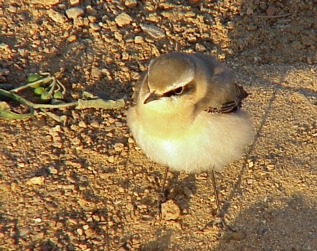
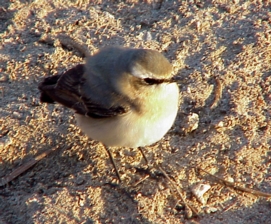
Autres oiseaux mystère/other mystery birds